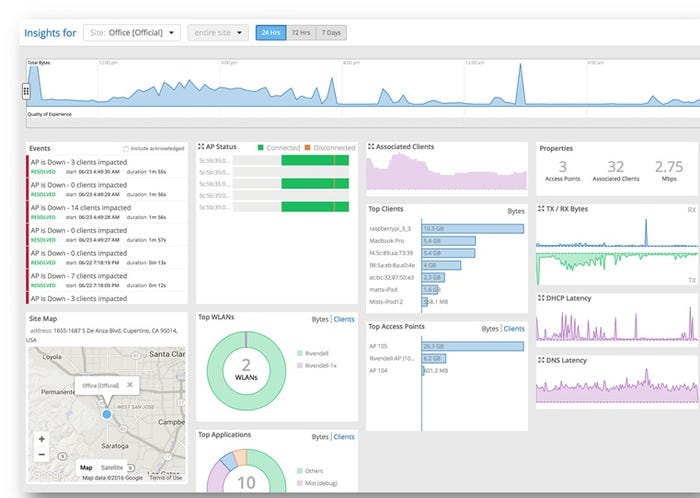WiFi Startup Promises Fresh Approach To The WLAN
Mist combines cloud-managed WiFi, analytics, SDN, and beacon-less location-based services.
June 30, 2016

Enterprise WiFi has become as much about big, sometimes exotic feature sets as much as simply getting users connected. For every new fast access point on the market, there’s some sort of new analytics, location-services or customer-engagement solution. Now, a startup called Mist Systems has introduced an altogether different WLAN framework that shows just how far WiFi has come.
Mist takes a thoroughly modern approach to WiFi that combines a number of hot technologies: Cloud-managed WLAN like Meraki and Aerohive and performance analytics similar to Nyansa, only without the need for an on-site collector appliance and with automatic triggers that start recording problem traffic for later “rewind” diagnostic playback. Mist also uses SDN to deliver “micro-experiences” to connected WLAN like Pertino (now owned by Cradlepoint), where topologies and services are administratively designed in software rather than at the port and VLAN level. On top of all that, the startup offers unique location-based services; more on that in a bit.
Mist executives, who are a mix of industry veterans and data scientists, emphasize the need to reimagine WiFi networking. They point out how wireless networking as most of us know it really hasn’t changed from the basic formula since before smartphones were invented. Sure, lots of features have been bolted on to the basic WLAN paradigm and we’ve seen management move to the cloud through the years, but Mist wants “next generation” to really mean something different.
This fairly radical philosophy comes from a team of co-founders that includes Sujai Hajela, Brett Galloway, and Bob Friday, who collectively had major hands in the rise of “thin” and cloud wireless and computing at Airespace and Cisco/Meraki, among other ventures.
Perhaps the best example of Mist's fresh combination of technologies is how it deploys beacons for location services. There are no physical beacons, like the rest of the WLAN industry uses. This means no battery concerns, no reconfiguring beacon locations when you make changes to the spaces those beacons operate in, and no separate beacon management system. Mist’s wireless access points are 4x4 802.11ac for WiFi, but they also have an integrated 16-element virtual Bluetooth Low Energy (vBLE) antenna array that lets you simply “place” virtual beacons on your dashboard floorplans as the antennas cover a huge area.

Mist Analytics.jpg
Mist claims that no accuracy is lost with virtual beacons, and this deployment methodology obviously eliminates the majority of beacon management overhead when you consider physically placing, occasionally moving, and changing batteries in traditional beacons. It’s fairly mind-blowing to see the virtual BLE demo, and I look forward to hearing if the wow factor translates to real-world production systems as Mist gains customers.
Mist executives shared some of their NDA beta sites with me and they have a number of Fortune 100 types in the mix.
I’m not saying Mist is guaranteed to get off the ground and succeed as a company just based on my hour spent with them. But I can say without reservation that the Mist WiFi, analytics, automated troubleshooting, virtual beacons, and micro-services technologies are collectively by far the most “next-gen” WLAN platform I’ve ever seen. It was captivating to the point where I felt like I was drinking from a fire hose trying to absorb it all during the demo, as it is so very much different from other WLAN solutions on the market.
Regardless of whether this newcomer lasts or falters, Mist is going to be an interesting company to follow.
About the Author
You May Also Like


